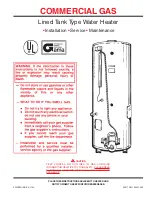
4
Spray can propellants, cleaning solvents, refrigerator and air
conditioning refrigerants, swimming pool chemicals, calcium
and sodium chloride (water softener salt), waxes, and process
chemicals contain typical compounds which are potentially
corrosive. Do not store products of this sort near the heater.
Also, air which is brought in contact with the heater should not
contain any of these chemicals. If necessary, uncontaminated
air should be obtained from remote or outside sources. The
limited warranty is voided when failure of water heater is due to
a corrosive atmosphere. (Refer to the limited warranty for
complete terms and conditions).
IMPROPER COMBUSTION
WARNING
ATTIC AND/OR EXHAUST FANS OPERATING ON THE PREMISES
WITH A WATER HEATER CAN RESULT IN CARBON MONOXIDE
POISONING AND DEATH.
OPERATING THESE FANS CAN PRODUCE A NEGATIVE DRAFT
IN THE AREA OF THE WATER HEATER PREVENTING THE
PRODUCTS OF COMBUSTION FROM EXHAUSTING THROUGH
THE CHIMNEY OR VENT PIPE.
The venting of the water heater should be inspected by a qualified
service technician at the time of installation and periodically
thereafter to ensure a down-draft condition does not exist.
DO NOT OBSTRUCT THE FLOW OF COMBUSTION AND
VENTILATING AIR. ADEQUATE AIR FOR COMBUSTION AND
VENTILATION MUST BE PROVIDED FOR SAFE OPERATION.
LIQUID PETROLEUM MODELS
Water heaters for propane or liquefied petroleum gas (LPG) are
different from natural gas models. A natural gas heater will not
function safely on LP gas and no attempt should be made to
convert a heater from natural gas to LP gas.
LP gas must be used with great caution. It is highly explosive
and heavier than air. It collects first in the low areas making its
odor difficult to detect at nose level. If LP gas is present or even
suspected, do not attempt to find the cause yourself. Go to a
neighbor’s house, leaving your doors open to ventilate the house,
then call your gas supplier or service agent. Keep area clear
until a service call has been made.
At times you may not be able to smell an LP gas leak. One
cause is odor fade, which is a loss of the chemical odorant that
gives LP gas its distinctive smell. Another cause can be your
physical condition, such as having a cold or diminishing sense
of smell with age. For these reasons, the use of a propane gas
detector is recommended.
Only trained LP professionals should conduct the required safety
checks in accordance with industry standards.
EXTENDED NON-USE PERIODS
WARNING
HYDROGEN GAS CAN BE PRODUCED IN A HOT WATER
SYSTEM SERVED BY THIS HEATER THAT HAS NOT BEEN USED
FOR A LONG PERIOD OF TIME (GENERALLY TWO WEEKS OR
MORE). HYDROGEN GAS IS EXTREMELY FLAMMABLE.
To
reduce the risk of injury under these conditions, it is
recommended that the hot water faucet be opened for several
minutes at the kitchen sink before using any electrical appliance
connected to the hot water system. If hydrogen is present, there
will probably be an unusual sound such as air escaping through
the pipe as the water begins to flow.
THERE SHOULD BE NO
SMOKING OR OPEN FLAME NEAR THE FAUCET AT THE TIME
IT IS OPEN.
INSULATION BLANKETS
Insulation blankets available to the general public for external
use on gas water heaters are not approved for use on your water
heater. The purpose of an insulation blanket is to reduce the
standby heat loss encountered with storage tank water heaters.
Your water heater meets or exceeds the ASHRAE/IES
90.1b-1992 standards with respect to insulation and standby
loss requirements making an insulation blanket unnecessary.
WARNING
Should you choose to apply an insulation blanket to this heater,
you should follow these instructions. Failure to follow these
instructions can result in fire, asphyxiation, serious personal injury
or death.
•
Do not apply insulation to the top of the water heater, as this
will interfere with safe operation of drafthood.
•
Do not cover the temperature & pressure relief valve.
•
Do not cover the instruction manual. Keep it on the side of the
water heater or nearby for future reference.
•
Do obtain new labels from manufacturer for placement on
the blanket directly over the existing labels.
HIGH ALTITUDE INSTALLATIONS
WARNING
INSTALLATIONS ABOVE 2000 FEET REQUIRE REPLACEMENT
OF THE BURNER ORIFICE IN ACCORDANCE WITH SECTION
8.1.2 OF THE NATIONAL FUEL GAS CODE (ANSI Z223.1).
FAILURE TO REPLACE THE ORIFICE WILL RESULT IN
IMPROPER AND INEFFICIENT OPERATION OF THE APPLIANCE
RESULTING IN THE PRODUCTION OF INCREASED LEVELS
OF CARBON MONOXIDE GAS IN EXCESS OF SAFE LIMITS
WHICH COULD RESULT IN SERIOUS PERSONAL INJURY OR
DEATH.
As elevation above sea level is increased, there is less oxygen
per cubic foot of air. Therefore, the heater input rate should be
reduced at high altitudes for satisfactory operation with the
reduced oxygen supply. Failure to make this reduction would
result in an overfiring of the heater, causing sooting, poor
combustion and/or unsatisfactory heater performance.
Ratings specified by manufacturers for most appliances apply
for elevations up to 2000 feet. For elevations above 2000 feet,
ratings must be reduced at the rate of 4% for each 1000 feet
above sea level. For example, if a heater is rated at 120,000 Btu/
hr. at sea level, to rate the heater at 4000 feet, you subtract 4
(once for each thousand feet) x .04 (4% input reduction) x 120,000
(the original rating) from the original rating. Therefore, to calculate
the input rating at 4000 feet: 4 x .04 x 120,000 = 19,200 btu/hr.,
120,000 - 19,200 = 100,800 btu/hr. At 6000 feet elevation, the
heater rating would be 91,200 btu/hr.





































